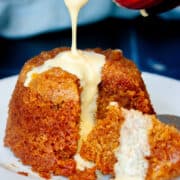
Syrup Steamed Pudding
Experience the delight of British syrup steamed pudding: moistsponge, sweet syrup. Stovetop-cooked, camping-favourite. Enjoy with custard onchilly nights.Before You StartGet your butter, eggs and milk out of the fridge in advance. The butter needs to be softened. Whilst this pudding will hang out quite happily for a touch longer in the steamer, it is best served immediately.
Servings: 6 people
Equipment
- 900ml pudding basin/or bowl (note)
- cooking twine/string
- steamer (note)
- baking paper
- foil
Ingredients
- Butter for greasing (about 10g)
- 90 ml golden syrup (6 tablespoons)
- Tablespoon lemon juice
- 150 g unsalted butter
- 150 g soft light brown sugar
- Pinch salt
- 2 eggs
- 150 g self-raising flour (note)
- 75 ml milk (5 tablespoons)
To Serve:
- Custard (hot or cold, or cream)
Instructions
- Grease Pudding Basin – rub a little softened butter around the inside of the pudding basin using your fingers.Butter for greasing
- Prepare Cover – cut/tear off a square of baking paper big enough to generous cover the top of the pudding basin. Cut/tear off a similar size piece of foil. Lay the foil square on top of the paper. Pleat in the middle to create some space for the pudding to rise. Set aside for now.
- Syrup – add the syrup and lemon juice to the bottom of the pudding basin and stir together.90 ml golden syrupTablespoon lemon juice
- Cream Butter & Sugar – place the very softened butter with the sugar and salt in a large bowl. Beat with a flexible spatula until well mixed and a bit fluffy.150 g unsalted butter150 g soft light brown sugarPinch salt
- Eggs – break the eggs into a small bowl and lightly whisk together using a fork or hand whisk. Gradually add to the creamed butter and sugar. A slightly curdled appearance is fine.2 eggs
- Flour & Milk – sift the flour over the eggy mix. Fold in the flour using a silicone spatula, followed by the milk. The mixture should be soft enough to fall off a spoon. Add a touch more milk if the batter is too stiff.150 g self-raising flour75 ml milk
- Spoon into Basin - spoon the batter into the basin and gently smooth the top to even out.
- Secure Cover – cover the basin with the foil uppermost. Secure around the lip of the basin with string. Make a string handle with a doubled-up length of string tied at opposite sides of the basin. Turn the foil and paper back on itself under the string.
- Steam - set the basin in a steamer deep enough to be able to take the basin and top with a well-fitting lid. Set the steamer over a saucepan of simmering water. The water doesn’t have to touch the bottom of the steamer. Steam the pudding for 2 hours. Every half hour or so, check the water level in the saucepan and top up as necessary to stop the water boiling dry. You can weigh the lid down with something heavy if need be.
- Serve – using the string handle, carefully lift the pudding out of the steamer. Cut the string and remove the layers of foil and paper. Run a knife around the inside of the basin. Place a plate over the top and and turn out onto a plate. Serve immediately with custard or cream.Custard
Notes
Pudding Basin - a deep ceramic bowl, wider at the top than the base, made for easy sealing with a cover using string. It has a step down at the side which helps hold string in place. If you don't have a pudding basin, a glass or ceramic bowl can work, though securing the cover might be a bit trickier.
Steamer – here, I’m referring to the classic double-pan one that stands over a saucepan. It needs to be deep enough to take the pudding basin and be able to put the lid on. if you don’t have one of these, all is not lost. A large lidded saucepan will do, one large enough to take the pudding basin. Place an upturned small plate in the bottom. Rest the pudding basin (prepared as normal) on the plate. Pour in enough water to come about ⅔ of the way up the sides. Simmer it for 2 hours with the pan lid on, checking and topping up the water level occasionally if required.
Self-Raising Flour – this is plain/all-purpose flour that already has raising agents added for convenience. This way you don’t have to add them separately. If you don’t have, replace with the same amount of plain/AP flour and add 1 ½ teaspoons of baking powder.
Make Ahead/Reheat
Unfortunately, I can't recommend doing either these things. The sponge becomes heavier as it cools. The whole appeal of this recipe is the light and airy sponge.
